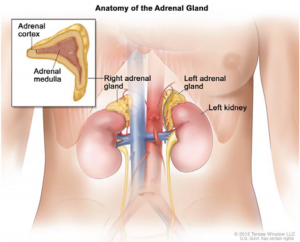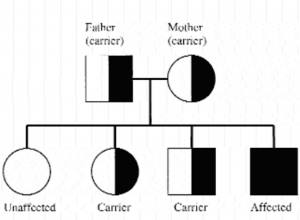Congenital Adrenal Hyperplasia
Printable PDF:
NIH Patient Education Facts about CAH -Congenital Adrenal Hyperplasia
What is CAH?
Congenital adrenal hyperplasia (CAH) is a genetic disorder of the adrenal glands that affects the body’s general health, growth, and development.
What are the adrenal glands?
The adrenal glands are a pair of walnut-sized organs above the kidneys. They make hormones, which act like chemical messengers that affect other organs in the body. An organ at the base of the brain, called the pituitary gland, helps regulate the adrenal glands. Each adrenal gland has two parts: the medulla (the inner part), and the cortex (the outer part). The medulla makes the hormone adrenaline. The cortex makes the hormones cortisol, aldosterone, and androgens. CAH affects how the adrenal cortex works. In severe cases, the adrenal medulla also may not function normally.

Figure 1: Anatomy of the adrenal gland (from Deborah P. Merke, MD, MS, Clinical Center)
What do adrenal hormones do?
Hormones made by the adrenal glands are important for the body’s normal functioning. Cortisol affects energy levels, sugar levels, blood pressure, and the body’s response to illness or injury. Aldosterone helps maintain the proper salt level and blood pressure. Androgens are hormones needed for normal growth and development in both boys and girls. Adrenaline affects blood sugar levels, blood pressure, and the body’s response to physical stress. The adrenal glands help keep the body in balance by making the right amounts of these hormones. In patients with CAH, there is an abnormal production of adrenal hormones.
Symptoms
Too little cortisol may cause tiredness, nausea, and weight loss. During illness or injury, low cortisol levels can lead to low blood pressure and even death. Also, treating a cortisol imbalance with too much cortisol can cause abnormal development in children, obesity, short stature, and decreased bone density (osteoporosis).
Lack of aldosterone, which occurs in three out of four patients with classic (severe) CAH, upsets salt levels. This imbalance may cause dehydration, and possibly death. Chronic salt imbalance may cause abnormal growth.
Too much androgen causes abnormal physical development in children. Boys and girls with CAH may either grow too fast, develop pubic hair and acne early, and/or stop growing too soon, causing short stature. Girls exposed to high levels of androgens before birth may have abnormal external genitalia at birth, and genital surgery is usually performed in infancy. Although their internal female organs are normal, excess androgens may affect puberty and cause irregular menstrual periods.
Classic CAH
The severe form of CAH is called classic CAH, and it occurs in 1 in 16,000 births. The most common is 21- hydroxylase deficiency, which makes up about 95 percent of cases. A child with this type of CAH has adrenal glands that cannot make enough cortisol and may or may not make aldosterone. As a result, the glands over- work trying to make these hormones and end up making too many androgens.
The second most common form of classic CAH is 11-hydroxylase deficiency. A child with this type of classic CAH has adrenal glands that make too much androgen and not enough cortisol. Children with this type of CAH may have high blood pressure. These patients do not have aldosterone deficiency.
Other rare types of classic CAH include 3-betahydroxy-steroid dehydrogenase deficiency, lipoid CAH, and 17- hydroxylase deficiency.
Non-classic (late-onset) CAH
The mild form of CAH is called non-classic CAH. This type of CAH is almost always due to 21-hydroxylase deficiency. Only a handful of people have been described as having non-classic CAH due to other causes. People with non-classic 21-hydroxylase deficiency usually make enough cortisol and aldosterone, but make excess androgens. Symptoms may come and go, beginning at any time, but typically develop in late childhood or early adulthood. Boys often do not need treatment, but girls often need treatment to suppress their excess androgens. Non-classic CAH is common. One in every 1,000 people has non-classic 21-hydroxylase deficiency. Incidence is higher in certain ethnic groups including Ashkenazi Jews, Hispanics, Yugoslavs, and Italians.
How is CAH inherited?
An inherited disorder is one that can be passed from the parents to their children. CAH is a type of inherited disorder called “autosomal recessive.” For a child to have CAH, each parent must either have CAH or carry a abnormal gene. This means that if two parents are CAH carriers (have the gene for CAH but not the disorder), then their children have a 25 percent chance (1 in 4) of being born with CAH. Each sibling without CAH has two chances in three of being a carrier. Tests can be done to find out if someone is a carrier.

Figure 2: Genetic Pedigree (from Deborah P. Merke, MD, MS, Clinical Center)
How is CAH treated?
People with CAH have a normal life expectancy, but CAH cannot be outgrown. Classic CAH requires treatment for life. Some patients with non-classic CAH may not require treatment as adults. Treatment is tailored for each patient and adjusted during childhood for growth. The standard treatment for children with classic CAH 21-hydroxylase deficiency is hydrocortisone which replaces cortisol and fludrocortisone which replaces aldosterone. For classic CAH 11-hydroxylase deficiency, the treatment is only hydrocortisone. Patients can be started on longer-acting forms of hydrocortisone-like medication (i.e. prednisone or dexamethasone) when they are done growing.
Patients with the non-classic form of CAH need only hydrocortisone (or a longer-acting form of hydrocortisone-like medication). Some patients with non-classic CAH are able to come off of medication as adults, but patients with classic CAH need lifelong treatment.
Experimental prenatal treatment is available for fetuses at risk for classic CAH. For this treatment, mothers take dexamethasone, a potent form of hydrocortisone-like medication. This medication suppresses androgens in the fetus and allows female genitalia to develop more normally. This treatment lessens or eliminates the need for surgery in girls. It does not, however, treat other aspects of the disorder. Children with CAH still need to take hydrocortisone and fludrocortisone for life.
What if a child or an adult with CAH has an illness, surgery, or a major injury?
During these times, a patient with CAH needs closer medical attention and should be under a doctor’s care. More cortisol is needed to meet the body’s increased needs for this hormone. Higher doses of hydrocortisone are given by mouth or sometimes by intramuscular injection (into the muscle). Intravenous medication is needed before surgery.
Medical Alert Identification
In an emergency, it is important to alert medical personnel about the diagnosis of adrenal insufficiency, so wearing a medical alert identification bracelet or necklace is recommended. The information on the medic alert should include, “Adrenal Insufficiency Requires Hydrocortisone.” It is important for the adult patient or parent of a child patient to learn how to administer an intramuscular injection of hydrocortisone in the case of an emergency.
Can a woman with CAH become pregnant and have a baby?
Increased androgens may cause irregular menstrual periods and make it harder for a woman with CAH to conceive a child. But if she takes her medications as directed, then she can become pregnant and have a baby.
Do men with CAH have fertility problems?
Men who take medications as directed usually have normal fertility. Rarely, however, they may develop “adrenal rest tissue” in their testes. This is when adrenal tissue grows in other parts of the body, such as the testes. The tissue does not turn into cancer, but it can grow enough to cause discomfort or infertility. Large growths are rare, and surgery is usually not needed.
Can CAH be diagnosed prenatally?
CAH can be diagnosed before birth. Amniocentesis or chorionic villus sampling during pregnancy can check for the disorder. Testing for classic CAH is part of the routine newborn screening done in all states in the United States.
What research is being done?
Researchers are working on many aspects of CAH including discovering new ways to diagnose and treat the disorder and finding the precise genetic defects that cause CAH. At NIH, scientists are learning more about CAH and are searching for better treatments for children and adults with CAH.